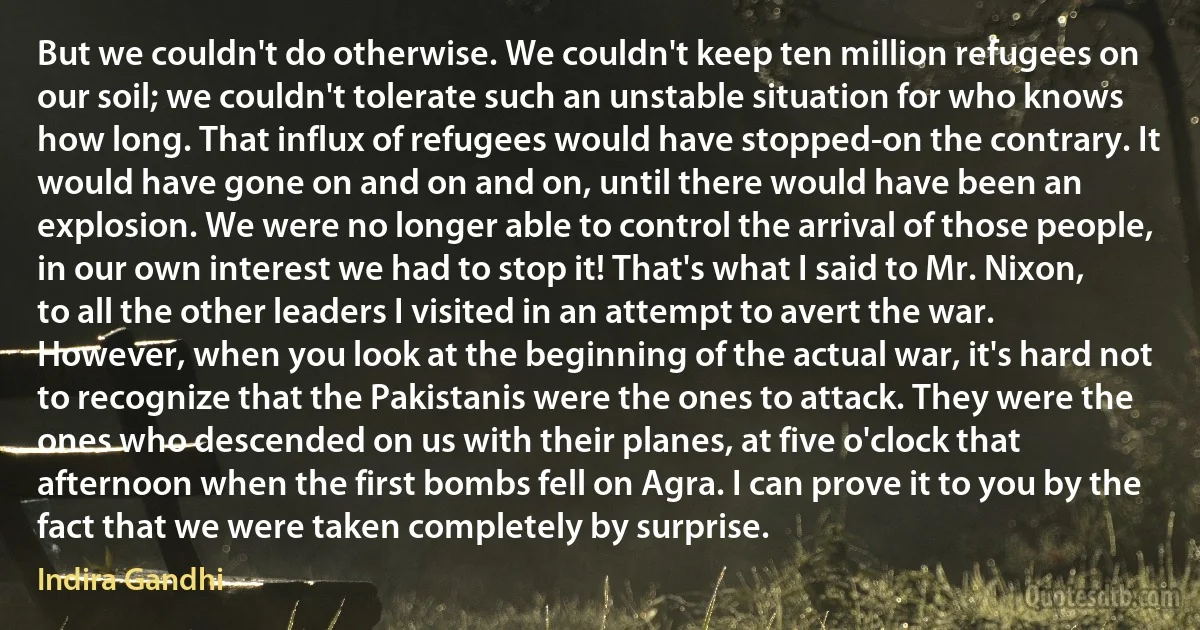Agra Quotes
I had planned to return to Lahore to join the college as an English student of MA. But something happened which changed my course. I chanced to meet a Professor who said I should migrate to Allahabad University where I could do both MA and Law in a period of two years. My father-in-law had some relatives in Agra who helped me to get admission in a college there.

Gulzarilal Nanda
It was an extraordinary display! Daily did this manner of slaughter and plundering proceed. And at night the shrieks of the women captives who were being raped, deafened the ears of the people...All those heads that had been cut off were built into pillars, and the captive men upon whose heads those bloody bundles had been brought in, were made to grind corn, and then their heads too were cut off. These things went on all the way to the city of Agra, nor was any part of the country spared.

Ahmed Shah Durrani
Everybody knows that the great reversed triangle of land, with its base in the north and its apex in the south, which is called India, embraces fourteen hundred thousand square miles, upon which is spread unequally a population of one hundred and eighty millions of souls. The British Crown exercises a real and despotic dominion over the larger portion of this vast country, and has a governor-general stationed at Calcutta, governors at Madras, Bombay, and in Bengal, and a lieutenant-governor at Agra.But British India, properly so called, only embraces seven hundred thousand square miles, and a population of from one hundred to one hundred and ten millions of inhabitants. A considerable portion of India is still free from British authority; and there are certain ferocious rajahs in the interior who are absolutely independent.

Jules Verne
Ahmad Shah Abdali in the year AH 1171 (AD 1757-58), came from the country of Kandahar to Hindastan, and on the 7th of Jumadal awwal of that year, had an interview with the Emperor ‘Ãlamgir II, at the palace of Shah-Jahanabad... After an interval of a month, he set out to coerce Raja Suraj Mal Jat, who from a distant period, had extended his sway over the province of Ãgra, as far as the environs of the city of Delhi. In three days he captured Balamgarh, situated at a distance of fifteen kos from Delhi... After causing a general massacre of the garrison he hastened towards Mathura, and having razed that ancient sanctuary of the Hindus to the ground, made all the idolaters fall a prey to his relentless sword...

Ahmed Shah Durrani
As an example, the exploits of one of Jahangir's commanders, Abdullah Khan Uzbeg Firoz Jung, can provide an idea of the excessive cruelty perpetrated by the government. Peter Mundy, who travelled from Agra to Patna in 1632 saw, during his four days' journey, 200 minars (pillars) on which a total of about 7000 heads were fixed with mortar. On his way back four months later, he noticed that meanwhile another 60 minars with between 2000 and 2400 heads had been added and that the erection of new ones had not yet stopped. Abdullah Khan's force of 12,000 horse and 20,000 foot destroyed, in the Kalpi-Kanauj area, all towns, took all their goods, their wives and children as slaves and beheaded and ‘immortered' the chiefest of their men.

Jahangir
But with the passing of time, a peasant became a tribal and from tribal a beast. William Finch, writing at Agra about 1610 C. E., describes how Jahangir and his nobles treated them - during Shikar. A favourite form of sport in Mughal India was the Kamargha, which consisted in enclosing a tract of country by a line of guards, and then gradually contracting the enclosure until a large quantity of game was encircled in a space of convenient size. "Whatever is taken in this enclosure” (Kamargha or human circle), writes Finch, "is called the king's shikar or game, whether men or beasts... The beasts taken, if man's meat, are sold... if men they remain the King's slaves, which he sends yearly to Kabul to barter for horses and dogs: these being poor, miserable, thievish people, that live in woods and deserts, little differing from beasts.”89 W. H. Moreland adds: "Other writer (also) tell it besides Finch.”.

Jahangir
Sikundur Lody, having returned to Dholpoor, reinstated the Raja Vinaik Dew, and then marching to Agra, he resolved to make that city his capital. He stayed in Agra during the rains, but in the year AH 910 (AD 1504), marched towards Mundril. Having taken that place, he destroyed the Hindoo temples, and caused mosques to be built in their stead.

Firishta
Having returned to Agra, the King proceeded in the year AH 912 (AD 1506) towards the fort of Hunwuntgur, despairing of reducing Gualiar. Hunwuntgur fell in a short time, and the Rajpoot garrison was put to the sword, the temples were destroyed, and mosques ordered to be built in their stead...

Firishta
...The Dehly army, arriving before Gualiar, invested the place... After the siege had been carried on for some months, the army of Ibrahim Lody at length got possession of an outwork at the foot of the hill, on which stood the fort of Badilgur. They found in that place a brazen bull, which had been for a long time an object of worship, and sent it to Agra, from whence it was afterwards conveyed to Dehly, and thrown down before the Bagdad gate (AH 924, AD 1518).

Firishta
Here the Shah halted for two days more. Meantime, as early as the night of 26-27 Feb., he had detached Jahan Khan and Najib with 20,000 men, telling them, "Move into the boundaries of the accursed Jat, and in every town and district held by him slay and plunder. The city of Mathura is a holy place of the Hindus; .... let it be put entirely to the edge of the sword. Up to Agra leave not a single place standing.” The Shah also conveyed a general order to the army to plunder and slay at every place they reached. Any booty they might take was declared a free gift to them. Any person cutting oft and bringing in heads of infidels should throw them down before the tent of the chief minister, wherewith to build a high tower.

Ahmed Shah Durrani


